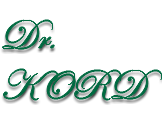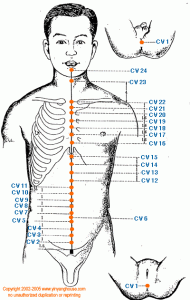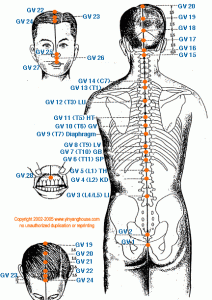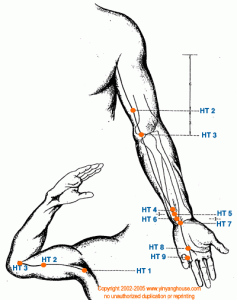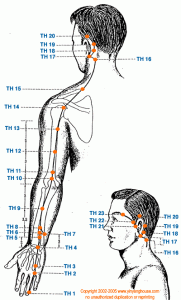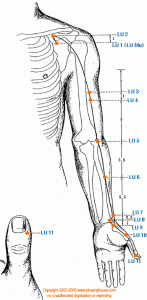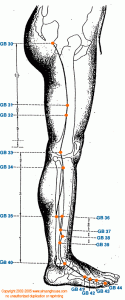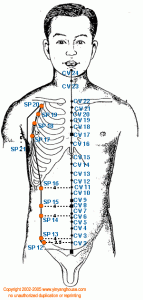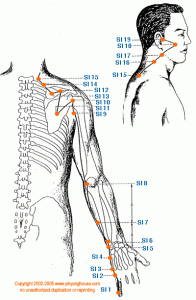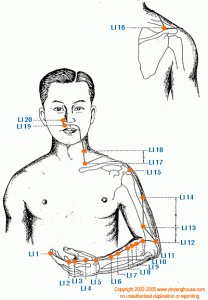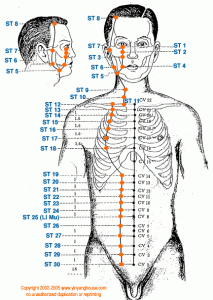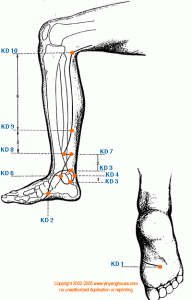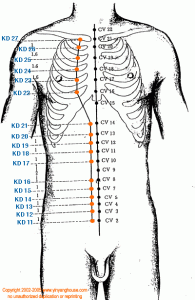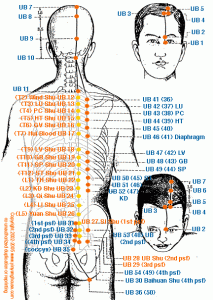Meridians:
Meridians are Energy Pathways inside the body. According to Traditional Chinese Medicine, major organs / systems in the body have their own Energy Pathways. Imbalances in a particular organ / system causes sensitivity & pain along the associated Energy Pathway.
Monitoring and directing all of the Yin channels (plus the stomach channel). The Conception Vessel is connected to the Thrusting and Yin Linking vessels, and is able to increase the Yin energy of the body. Tbis vessel nourishes the uterus (one of the five ancestral organs) and the whole genital system. It is said in the Nei Jing that the Conception and Thrusting vessels contain both blood and essence (Jing), and both flow up to the face and around the mouth. They contain more blood than essence in men, and thus promote the growth of the beard and body hair. Because women lose blood with their menstruation, they contain proportionately less blood and hence, no beard or body hair.
It was described in the Su Wen that both the Conception and Thrusting vessels control the life cycles every 7 years for women and every 8 years for men. It is the changes taking place in these vessels at those intervals that promote the major alterations in our lives.
In addition, the Conception vessel also controls the distribution and “dispersion” of Guardian Qi all over the abdomen and thorax via numerous small Qi branches (Luo). This vessel also plays an important role in the distribution of body fluids in the abdomen.
In Qigong society, this vessel and the Governing vessel are considered the most important among the Qi channels and vessels, and must be trained first. It is believed that there is usually no significant Qi stagnation in the Conception vessel. However, it is important to increase the amount of Qi you are able to store, which also increases your ability to regulate the Yin channels
The Governing Vessel is the confluence of all the Yang channels, over which it is said to “govern.” Because it controls all the Yang channels, it is called the “Sea of Yang Meridians.” This is apparent from its pathway because it flows up the midline of the back, a Yang area, and in the center of all Yang channels (except the stomach channel which flows in the front). The Governing Vessel governs all the Yang channels, which means that it can be used to increase the Yang energy of the body.
Since the Governing Vessel is the “Sea of Yang Meridians” and it controls or governs the back, the area richest in Guardian Qi (Wei Qi), it is also responsible for the circulation of the body’s Guardian Qi to guard against external evil intruders. The circulation of Guardian Qi starts from Fengfu (Gv-lG), and moves down the Governing Vessel to Huiyin (LI-l). It is said that it takes 21 days for the Guardian Qi to flow from Fengfu to Huiyin, and 9 days from Huiyin to the throat, making it a monthly cycle.
According to Chinese medical science, Guardian Qi is Yang Qi and therefore represents the “Fire” of the body. Its quick and ubiquitous circulation keeps the fire going in the body and controls the loss of body heat. Guardian Qi is also inextricably linked with the fluids that flow outside the channels, in the skin and flesh. Consequently, through the breathing (under control of the lungs), Guardian Qi is responsible for the opening and the closing of the pores, and also controls sweating.
The Governing vessel is also responsible for nourishing the five ancestral organs, which include the brain and spinal cord. This is one of the ways in which the kidneys “control” the brain, as is said in Chinese medicine.
Because of their importance to health, the Governing vessel and the Conception vessel are considered the two most important Qi channels to be trained in Qigong, especially in Nei Dan. Training related to these two vessels includes: 1. How to fill them with Qi so that you have enough to regulate the twelve channels, 2. How to open up stagnant areas in these two vessels so that the Qi flows smoothly and strongly, 3. How to effectively direct the Qi to nourish the brain and raise up the Shen, 4. How to effectively govern the Qi in the twelve channels, and nourish the organs, 5. How to use your raised Shen to lead the Guardian Qi to the skin and strengthen the Guardian Qi shield covering your body.
In Nei Dan Qigong training, when you have filled up the Qi in these two vessels and can effectively circulate the Qi in them, you have achieved the “Small Circulation.” In order to do this, you must know how to convert the essence stored in the kidneys into Qi, circulate this Qi in the Governing and Conception vessels, and finally lead this Qi to the head to nourish the brain and Shen (spirit).
The heart in Chinese medicine is one of the most important organs in the entire body, it is referred to as the Monarch. The heart is in charge of governing the blood, controlling the blood vessels, and housing the mind (called the Shen in Chinese medicine). The function of governing the blood and controlling the blood vessels overlaps with the function of the heart in western medicine which is to pump blood through the entire body. Even the idea of the heart housing the mind can be easily explained in western medicine. The mind, or the brain, needs a huge amount of nutrients and blood flow at all times in order to properly function. When our blood is deficient in nutrients (like when people are on unhealthy diets) the brain function will slowly deteriorate. This can be seen as poor concentration, bad memory, and fatigue. Also, if the heart is not functioning properly, we can see similar impacts. Another explanation for the heart housing the mind can be seen with our emotions. A lot of religions and spiritual belief systems suggest people to live from their hearts in order to have an inspired life. This again suggests a relationship between our ability to think and our hearts. The main emotion of the heart, in Chinese medicine, is joy. It is said that too much joy or too little joy can hurt the heart. A healthy heart can be shown in our facial complexion and the tip of the tongue shows heart imbalances. The body fluid of the heart is sweat and the main color of the heart is red. Last, the heart impacts our dreams when it is imbalanced.
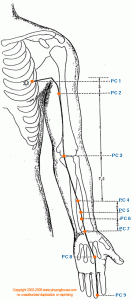 Pericardium (Circulation) Meridian:
Pericardium (Circulation) Meridian:
The pericardium in Chinese medicine has the same function as in western medicine; to protect the heart. The pericardium meridian is used in a very similar manner as the heart meridian because they both have a close relationship with the mind. We use the pericardium meridian to help calm the mind, to help people sleep better and to help patients balance their emotions.
Triple Warmer (Endocrine) Meridian:
The San Jiao meridian is identified by many names like the Triple Burner or the Triple Warmer. The San Jiao is broken into three parts, the Upper Burner, the Middle Burner and the Lower Burner (aka triple burner). It is said that the Upper burner is like a mist, the Middle burner is like a froth of bubbles and the lower burner is like a drainage ditch. What this means is that the Upper burner, which includes the lungs and heart, has the function of distributing the lung Qi and fluid. In other words, it takes the energy we gain from the air and moves it throughout the entire body (the circulatory system). The middle burner includes the spleen (aka the pancreas), the liver, and the stomach and its main function is to help in the fermentation of food (digestion process). And last, the lower burner includes the kidneys, the urinary bladder, the large intestine and the small intestine. Its main function is the separation of good, usable energy, from bad, unwanted energy. In Chinese medicine, this is called “separating the clear from the turbid,” or in other words, separating the nutrients our body needs from the garbage it will be getting rid of. As you can see the San Jiao meridian includes the entire body, the upper, the middle and the lower but the description of where the San Jiao is located seems to be elusive. How can some bodily function incorporate all of the organs and yet not be an organ? Let me tell you a little more about the functions of the San Jiao, in Chinese medicine, before we piece it all together.
The functions of the San Jiao meridian is to move your Yuan Qi, which is the energy that was given to you from your parents at birth, from the Kidneys to the rest of the organs. The San Jiao is also in charge of moving bodily fluid throughout the entire body and it regulates water metabolism. Now lets compare this description to the western medicine description of the lymphatic system.
In western medicine, the lymphatic system is a system of bodily fluid that circulates, without the help of the heart, around the entire body due to pressure systems within the cells (the function of water metabolism in Chinese medicine). Its function is to aid the immune system in destroying pathogens and removing waste (the Yuan Qi is the immune system given to you by your parents), it removes dead or cancerous cells (separating clear from turbid), and it works with the circulatory system to deliver oxygen and nutrients to cells (the triple burner). This description matches perfectly with the Chinese medicine function of the San Jiao.
The lungs in Chinese medicine have many functions. They are in charge of grasping the energy from the outside world (air) which we call Qing Qi. When the lungs are functioning in balance they descend and disperse the Qing Qi throughout the entire body. The lungs regulate water passages by circulating and excreting fluids. The health of the lungs is reflected in our skin and the hair on our skin. Any kind of rashes, acne or skin trouble can possibly be a dysfunction of the lungs. Last, the emotion of the lungs is grief. When we are impacted by grief in our lives, the lungs or the chest is typically involved in some way.
In western medicine we can find correlations to the function of the lungs in Chinese medicine. In terms of Qing Qi and the descending and dispersing function of the lungs, this is the equivalent of the function of hemoglobin in our blood. Hemoglobin supplies every cell in our body with oxygen; when we inhale, the hemoglobin descends oxygen and disperses it via the circulation system. The function of circulating and excreting fluids can be explained by noticing the amount of fluids we lose through our breath and the close relationship our lungs have with the heart and the circulation system. The reflection of the lungs in the skin can be shown by many examples including the blue color our skin turns when we are having trouble breathing. And last, when we have experience grief in our lives, many people have the sensation of a tight chest and shallow breath. This is why the Chinese place grief in the lungs. These are all the functions of the lungs in Chinese medicine. Below is the lung meridian.
The liver is a fascinating organ. It performs over 500 vital functions in the body plus many more that are still being discovered. The liver plays a big role in both Chinese medicine and western medicine. In western medicine the liver produces bile which helps break down fats and carry away waste in the small intestines. It also produces certain proteins in blood plasma, it converts excess glucose into glycogen, it regulates blood clotting factors and it is a huge detoxifier, just to name a few. In Chinese medicine the liver is in charge of storing blood, regulating menstruation, controlling the smooth flow of Qi (our body’s energy) and it ensures the flow of bile. The liver is also an organ that is easily impacted by emotions and stress. Living a stressful life or living in a stressful emotional state is equally as toxic as any physical toxic substance. This means that when we are overly stressed or emotional our liver has to perform the same detoxifying functions as it would with any poisonous substance. When the liver becomes overwhelmed, the Qi stagnates causing Liver Qi Stagnation, one of the most common diagnoses for Americans in Chinese medicine. Since the liver is in charge of the smooth flow of Qi, when the liver Qi stagnates, it halts the smooth movement of Qi in the entire body. Here are the common symptoms of liver Qi stagnation- hypochondriac pain (pain in the area on the side of ribs), moodiness, depression, feeling of a lump in your throat, chest tightness, irregular periods, and breast tenderness before the period.
Gallbladder Meridian:
The gall bladder in Chinese medicine has some similarities to the gall bladder in western medicine. It’s job is to store and excrete bile. Bile is used in the small intestine to help digest fats in our food. Where Chinese medicine differs is the intimate relationship the gall bladder has with the liver and the heart. The liver is in charge of moving our Qi throughout the body. In other words, the energy in our body that keeps us healthy and nourished is governed by the liver. When we are overly emotional or stressed, the liver becomes unbalanced and our Qi stagnates. The gall bladder has very similar functions to the liver. It’s Qi helps keep the liver moving smoothly. And vice versa, the liver Qi helps keep the gall bladder in balance and helps it excrete bile smoothly. Another similar function the gall bladder has with the liver is nourishing the sinews. The liver supplies the blood to nourish our sinews while the gall bladder supplies the Qi to nourish our sinews. Sinews are a piece of fibrous tissue that connect muscle to bone or bone to bone. The sinew meeting point, the acupuncture point that connects all the sinews, is on the gall bladder channel (GB-34).
Another important function of the gall bladder is its mental influence. The gall bladder is in charge of our decisiveness, our capacity to make decisions. The gall bladder gives us the courage to make change and to move forward. It also influences our mental decisiveness which is the relationship it has with the heart (because the heart controls the mind). In five element theory, the gall bladder is wood, the heart is fire and wood controls fire. This shows the interrelationship between the decisiveness of the gall bladder and the mental influence of the mind.
The last function of the gall bladder is its influence on our ability to sleep. The gall bladder helps a person sleep long and have a good quality of sleep. If the gall bladder is deficient then a person will wake up early in the morning and be unable to fall asleep again.
Spleen Meridian:
The spleen in Chinese medicine is in charge of many key processes within our bodies. I want to clarify upfront that the Chinese medicine spleen is very different from the western medicine spleen. In western medicine the spleen is part of the lymphatic system or the immune system, where as in Chinese medicine the spleen deals with digestion. Why is there such a huge difference in the spleen function between cultures? The answer, in my opinion, lies within the history of how these medicines evolved. In the Chinese culture, for thousands of years, it was considered inappropriate to dissect a human body. Therefore, a lot of the early Chinese theory about the body was inaccurate. Western medicine, however, was completely different in its approach and was very familiar with the human body. Each approach allowed for different development of medicine theories, western medicine is focused on very small parts of the body while Chinese medicine is focused on the overall whole system. To make a long story short, the spleen in Chinese medicine should probably be called the pancreas due to its contributions to the digestive process. Please keep this in mind as you read on about the functions of the spleen.
The spleen has many functions in Chinese medicine. First, the spleen is in charge of the transformation and transportation process. Transformation refers to the transformative process where food is broken down and energy is gained. The transportation process refers to the movement of this energy throughout the body. The “food energy” is called the Gu Qi in Chinese medicine. This energy ascends into the lungs from the spleen to be distributed by the circulation system. Without the Gu Qi our bodies would not have enough energy to properly function. Another function of the spleen is to provide energy to keep the blood inside the blood vessels. As a result, if the spleen is imbalanced, we end up with a lot of bleeding signs and symptoms. A third function of the spleen is to help regulate water passages within the body. This is why dampness accumulates when the spleen is not working properly. A fourth function of the spleen is to control the health and movement of our muscles. This is easily explained in western medicine when someone either doesn’t eat enough or has chronic bad digestion. One of the first things that the body breaks down is our muscles. These are the basic functions of the spleen in Chinese medicine.
There are many signs and symptoms of the spleen working improperly. If the spleen doesn’t have enough energy to do its job then a patient is diagnosed with Spleen Qi Deficiency. The symptoms of this are as follows: pale face, fatigue, poor appetite, loose stools, and bloating.
The small intestine in Chinese medicine has a very similar function to that of western medicine. The small intestine’s job is to receive food from the stomach and “separate the clear from turbid.” What this means is that the small intestine separates our food into usable energy (clear) and waste products (turbid). The clear energy goes back up to the spleen to be distributed throughout our entire body and the turbid energy goes down into the large intestine/urinary bladder (which in turn removes it). The small intestine in both Chinese and western medicine is the main digestive organ in our body.
The functions of the large intestines in Chinese medicine are similar to the functions of the large intestines in western medicine. The large intestines receive waste from the small intestines, they excrete waste from the body, and they reabsorb water. It is a yang organ whose paired yin organ are the lungs. The time of day when the large intestines are at their peak function is between 5-7am in the morning. This suggests that having a bowel movement in the morning is preferred over any other time during the day. Here is the large intestine meridian.
The stomach in Chinese medicine has the same function as the stomach in western medicine. The stomach’s job is to receive food and begin the degrading process of food. The stomach works in conjunction with the spleen to take energy from the food we eat and transport it throughout our bodies.
Kidney Meridian:
The kidneys are one of the most important organs in Chinese medicine. They have many functions that do not coincide with western medicine. The only similarity that is shared between the east and west in regards to kidney function is its regulation of water in the body. In Chinese medicine, the kidneys store our essence or Jing. Essence is the life force given to us from our parents that allows us to develop and grow in a full, healthy way. Kids who are considered to have a Jing or essence deficiency can be developmentally challenged, can be born with diseases, can mature slowly, or not grow to their full height. Since the kidneys store our Jing it should not be surprising that other functions of the kidneys include controlling our growth and development, reproduction and bone growth.
Western medicine has its own equivalent of Jing but they call it the endocrine system. The endocrine system is a group of glands that regulates our body by releasing hormones directly into the blood stream. These glands (and their hormones) control our growth, our temperature, our metabolism, our blood pressure, our reproductive systems among a million other functions. The endocrine system is considered to be part of the kidneys functions within Chinese medicine.
Urinary Bladder Meridian:
The urinary bladder in Chinese medicine has a similar function as it does in western medicine, to store urine. Its function is straight forward but the meridian does a lot of wonderful things.
As you can see the Urinary Bladder is a huge meridian, the biggest meridian in the entire body. It has a total of 67 acupuncture points and runs from the inner corner of the eye, up the forehead, down the back (twice), down the back of the legs to the outside of the pinky toe. The time of the Urinary Bladder is from 3-5 pm. The Urinary Bladder Meridian is also called the Foot Tai Yang Meridian. It is paired with the Hand Tai Yang Meridian, also known as the Small Intestine Meridian. This shows a relationship between our digestive tract and the excretion of urine. The urinary bladder is a yang organ with its paired yin organ being the kidneys. Both of the these organs deal with the regulation of water in the body. Other things to note with the Urinary Bladder Meridian is that it is used quite often in the treatment of back pain and for the regulation of every organ in the body. This is because the channel runs next to every nerve root that comes out of the spine. The Urinary Bladder Meridian runs down the back twice, the inner channel interacts with the nerve roots while the outer channel deals with balancing the emotions associated with every organ. This shows how important the Urinary Bladder Meridian is to any acupuncture treatment. Below are some common points used on this channel.
